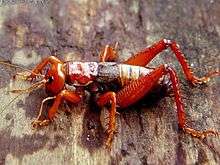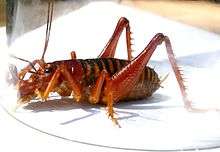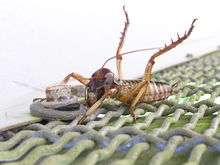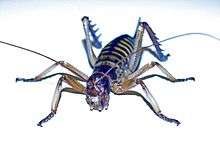Anostostomatidae
| Anostostomatidae | |
|---|---|
 | |
| Poor Knights giant weta, Deinacrida fallai Overall length 20 cm (8 in) | |
| Scientific classification | |
| Kingdom: | Animalia |
| Phylum: | Arthropoda |
| Class: | Insecta |
| Order: | Orthoptera |
| Suborder: | Ensifera |
| Superfamily: | Stenopelmatoidea |
| Family: | Anostostomatidae Saussure, 1859 |
| Subfamilies and genera | |
|
See text. | |
Anostostomatidae is a family in the order Orthoptera, widely distributed in the southern hemisphere. It is sometimes referred to as Mimnermidae or Henicidae in some taxonomies, and common names include king crickets in South Africa and weta in New Zealand. Prominent members include the Parktown prawn of South Africa, and the giant weta of New Zealand. The cave weta belong to another family, the Rhaphidophoridae. The distribution of this family reflects a common ancestry before the fragmenting of Gondwana.
General characteristics
By virtue of their ability to cope with variations in temperature, members of the Anostostomatidae family can be found in a variety of environments including alpine, forests, grasslands, shrub lands and urban gardens. The family is widely distributed across southern hemisphere lands including South America, Australia, South Africa and New Zealand. They are nocturnal and many are flightless although several flying species exist in Australia. The diet is diverse, rarely consisting of leaves, and more commonly a combination of other insects, fungi, dead animals, and fruit. An Australian king cricket can overpower and eat funnel-web spiders.[1]

Taxonomy and evolution
At least one Cretaceous fossil of an anostostomatid-like cricket is known from Australia but has not been described. The modern distribution of this family on lands in the southern hemisphere has led to speculation that members of this group owe their distribution to the breakup of the ancient supercontinent Gondwana. This may be the case but evidence for the large scale if not total submergence of continental crust in the New Zealand and New Caledonian region in the Oligocene, indicates the possibility that weta have arrived in these locations at least, since re-emergence of land. The fact that anostostomatid crickets also occur on some Japanese islands supports this possibility.

The king crickets of South Africa
The best-known species is the Parktown prawn, not to be confused with the well-known Koringkrieke or armoured ground crickets, which never have been in the family Anostostomatidae.
Henicus monstrosus is a nocturnal anostostomatid. The males are unusual in their anatomy; their heads are disproportionately large and bear forward-directed prongs. They have extremely long, curved mandibles that are functional, but seem to play no part in the eating process.[2]
The weta of New Zealand

New Zealand had no native land mammals apart from native bats immediately before humans arrived, but Miocene fossils indicate terrestrial mammals probably existed at that time. In New Zealand, anostostomatid crickets (weta) are ecologically diverse and occupy a wide range of habitat types. Some genera are primarily predators or scavengers, whilst others – notably the so-called tree weta Hemideina and their close relatives the giant weta Deinacrida – can bite. Tree weta bites are not particularly common. They can also inflict painful scratches with the potential of infection. Weta are known to arc their hind legs into the air in warning to foes and use acoustic communication (stridulation) to signal to one another .
The five weta groups in New Zealand
- Giant weta
- Tree weta
- Tusked weta and Northland tusked weta
- Ground weta
- Cave weta (in another family, the Rhaphidophoridae)

Subfamilies and genera
- Subfamily Anostostomatinae Saussure, 1859
- Aistus
- Anabropsis
- Anostostoma
- Apotetamenus
- Apteranabropsis
- Bochus
- Borborothis
- Brachyporus
- Carcinopsis
- Cnemotettix
- Cratomelus
- Exogryllacris
- Glaphyrosoma
- Gryllotaurus
- Hemiandrus, ground weta
- Henicus
- Hydrolutos
- Hypocophoides
- Hypocophus
- Leponosandrus
- Libanasa
- Libanasidus, king crickets
- Licodia
- Lutosa
- Motuweta, tusked weta
- Nasidius
- Neolutosa
- Onosandridus
- Onosandrus
- Papuaistus
- Paterdecolyus
- Penalva
- Spizaphilus
- Subfamily Deinacridinae
- Anisoura, Northland tusked weta
- Deinacrida, giant weta
- Gryllacropsis (from India, only tentatively assigned to Deinacridinae)
- Hemideina, tree weta
- Subfamily Leiomelinae
References
- ↑ King Cricket eating Funnel-web-Spider at Australian Museum website.
- ↑ African Insect Life - SH Skaife (Longmans Green & Co,1953)
- Johns, P.M. 1997: The Gondwanaland weta: family Anostostomatidae (formerly in Stenopelmatidae, Henicidae or Mimnermidae): nomenclatural problems, world checklist, new genera and species. Journal of Orthoptera Research, 6: 125-138. ISSN 1082-6467 JSTOR
External links
| Wikispecies has information related to: Anostostomatidae |